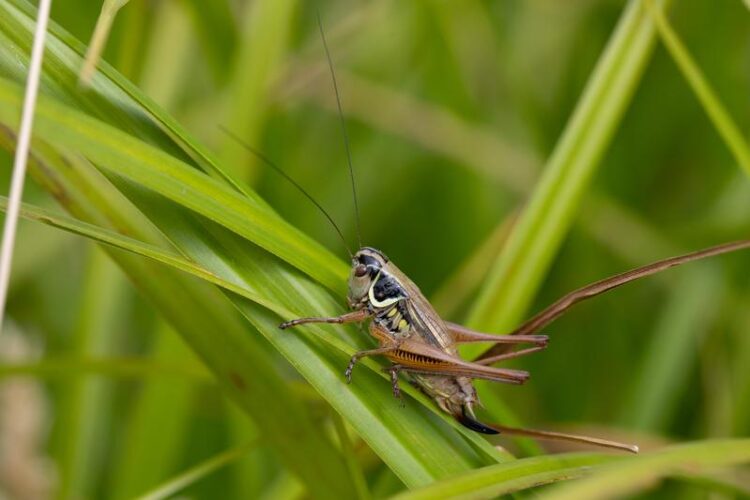How climate change is disrupting ecosystems

Roesel's bush-cricket is one of the many grasshoppers that might migrate to higher elevations once the climate in lower elevations has become unsuitable.
Photograph: Christian Roesti
The world is getting warmer and warmer – and many organisms native to lower latitudes or elevations are moving higher.
However, novel organisms moving into a new habitat could disturb the ecological balance which has been established over a long period. Plants and herbivores are characterised by long-term co-evolution, shaping both their geographic distribution and the characteristics that they display in their occupied sites.
At higher elevations, this is seen in insect herbivores being generally less abundant and plants in turn being less well defended against herbivores, as a result of lower energy and shorter growing seasons. In contrast, low-elevation plant species defend themselves against more abundant and diverse herbivores, whether by means of spikes, thorns or hair, or by toxic substances. Climate change could disturb this ecological organisation.
Grasshoppers translocated to high elevations
In an experiment, researchers from ETH Zurich, the Swiss Federal Institute for Forest, Snow and Landscape Research (WSL) and the University of Neuchâtel investigated what could happen if herbivores – in this case various grasshoppers from middle elevations – settled in alpine meadows at higher elevations and encountered new plant communities there. The study has just been published in the journal Science.
The researchers translocated various grasshopper species from medium altitudes (1,400 metres above sea level) to three alpine grassland sites at elevations of 1,800, 2,070 and 2,270 metres above sea level, where the ecologists placed the grasshoppers in cages. The local grasshoppers had previously been removed from the experimental areas. The experiment was carried out in the Anzeindaz region in the Vaud Alps, Switzerland.
In their study, the researchers measured things like how the biomass, structure and composition of the alpine plant communities changed under the influence of the herbivorous insects. The researchers also investigated whether some plant species were more susceptible to herbivory, for instance plants with tougher leaves, or those containing more silica or other constituents such as phenols or tannins.
Lowland grasshoppers influence alpine community
The ecologists discovered that the grasshoppers’ feeding behaviour had a clear influence on the vegetation structure and composition of the alpine flora. Alpine communities display clear structure in the organisation of the canopy, with plants with tough leaves at the top, and more shade-tolerant plants with softer leaves at the bottom. But this natural organisation was disturbed, because the translocated grasshoppers preferred to feed on taller and tough alpine plants, which exhibited functional characteristics such as leaf structure, nutrient content, chemical defence, or growth form similar to those of their previous, lower-elevation food plants. As a result, the insects reduced the biomass of dominant tough alpine plants, which in turn favoured the growth of small-stature plant species that herbivores avoid. The overall plant diversity thus increased in the short term.
“Immigrant herbivores consume specific plants in their new location and this changes and reorganises the competitive interaction between those alpine plant species,” says the study’s first author, Patrice Descombes. Global warming, for example, could disrupt the ecological balance because mobile animals, including many herbivorous insects, can expand their habitat to higher elevations more rapidly than sedentary plants. Herbivorous insects from lower altitudes could therefore have an easy time in alpine habitats with resident plants that are insufficiently or not at all prepared to defend themselves against those new herbivores. This could change the current structure and functioning of alpine plant communities as a whole. Climate change would thus have an indirect impact on ecosystems, in addition to the direct consequences of rising temperatures.
Important drivers of changed ecosystems
For Loïc Pellisier, Professor of Landscape Ecology at ETH Zurich and WSL, this indirect effect of climate change on ecosystems is one of the most important things to emerge from the study: “Climate impact research has largely investigated the direct effects of temperature on ecosystems, but these novel interactions that arise between species moving into new habitats could generate important structural modifications. They are important drivers of changed ecosystems in an increasingly warm climate.”
With their results, the researchers also want to improve models that have so far only inadequately integrated such processes. They also hope that this will improve the prognosis of how climate change will influence the functioning of ecosystems and the services they provide.
All latest news from the category: Ecology, The Environment and Conservation
This complex theme deals primarily with interactions between organisms and the environmental factors that impact them, but to a greater extent between individual inanimate environmental factors.
innovations-report offers informative reports and articles on topics such as climate protection, landscape conservation, ecological systems, wildlife and nature parks and ecosystem efficiency and balance.
Newest articles

Innovative 3D printed scaffolds offer new hope for bone healing
Researchers at the Institute for Bioengineering of Catalonia have developed novel 3D printed PLA-CaP scaffolds that promote blood vessel formation, ensuring better healing and regeneration of bone tissue. Bone is…

The surprising role of gut infection in Alzheimer’s disease
ASU- and Banner Alzheimer’s Institute-led study implicates link between a common virus and the disease, which travels from the gut to the brain and may be a target for antiviral…

Molecular gardening: New enzymes discovered for protein modification pruning
How deubiquitinases USP53 and USP54 cleave long polyubiquitin chains and how the former is linked to liver disease in children. Deubiquitinases (DUBs) are enzymes used by cells to trim protein…



